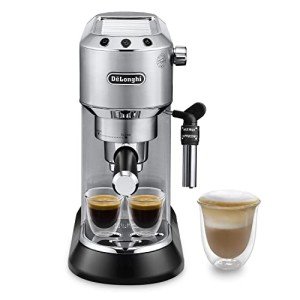Heat Exchange Espresso Machines: A Comprehensive Guide
Espresso machines have actually progressed considerably for many years, catering to the needs of home baristas and coffee experts alike. Amongst these machines, heat exchange espresso machines have gained popularity due to their capability to deliver consistent efficiency and remarkable brew quality. In this short article, we will explore the workings, advantages, and essential features of heat exchange espresso machines, providing a comprehensive understanding for both potential purchasers and coffee lovers.
Understanding Heat Exchange Technology
Heat exchange espresso machines operate on an unique principle that enables synchronised water heating for developing and steaming. They are geared up with a single boiler that utilizes a heat exchanger system. This function is substantial as it enables users to brew espresso while steaming milk concurrently, promoting efficiency in the coffee-making procedure.
How Does a Heat Exchange Espresso Machine Work?
The process begins with the machine's water inlet filling the boiler. As the water heats up, it turns to steam. The innovative heat exchanger uses hot steam to heat extra water in a separate passage developed particularly for the brew group. This suggests that water can reach the ideal brewing temperature without awaiting the boiler to change. The key steps include:
- Water Fill: Water is drawn into the boiler.
- Heating Process: The boiler warms up as water is converted into steam.
- Heat Exchange: Steam warms water in the heat exchanger tube.
- Developing: Water from the heat exchanger is pressed through coffee premises, extracting the flavors required for an abundant espresso.
This procedure permits fast temperature level modifications and improved coffee extraction.
Advantages of Heat Exchange Espresso Machines
Heat exchange espresso machines offer several benefits, especially for those aiming to maximize their coffee experience. Here are some essential benefits:
- Simultaneous Brewing and Steaming: Users can brew espresso while steaming milk, making it ideal for hectic coffee shops and home baristas who value effectiveness.
- Temperature level Stability: The boiler's steam pressure assists preserve a steady temperature level, which is vital for constant espresso extraction.
- Flexibility: The design enables fast changing in between brewing and steaming, making it simpler to create various coffee drinks, from lattes to coffees.
- Easy to use: Models typically feature accessible controls, making it feasible for both beginners and experienced baristas to produce quality beverages.
- Professional Quality: Heat exchange machines are typically used in commercial settings, offering users with high-quality brewing performance at home.
Secret Features to Look for in Heat Exchange Espresso Machines
When thinking about the purchase of a heat exchange espresso machine, there are several features that one need to take into account:
- Build Quality: Look for machines made of long lasting materials, such as stainless-steel or brass, ensuring durability.
- Boiler Size: A bigger boiler will hold more water and sustain greater output with time.
- PID Temperature Control: This feature helps maintain constant brew temperatures, which can boost the coffee-making procedure.
- Group Head Design: Machines with a saturated or semi-saturated group head supply better temperature stability.
- Relieve of Use: User-friendly user interfaces and instinctive controls enhance the general experience for baristas at all ability levels.
- Steam Wand Quality: An excellent steam wand with correct insulation and flexibility permits better texturing of milk.
- Water Reservoir Size: Depending on your needs, consider how frequently you wish to refill the water reservoir.
Contrast of Popular Heat Exchange Espresso Machines
To much better understand the choices readily available in the market, listed below is a contrast table of some popular heat exchange espresso machines:
| Machine Model | Boiler Size | PID Control | Cost Range | User Ratings |
|---|---|---|---|---|
| Profitec Pro 700 | 2.0 L | Yes | ₤ 2,000-₤ 2,500 | 9.5/ 10 |
| Rocket Espresso R58 | 1.8 L | Yes | ₤ 2,400-₤ 2,800 | 9.4/ 10 |
| Elekta Bianca | 1.8 L | Yes | ₤ 2,500-₤ 3,000 | 9.6/ 10 |
| La Spaziale S1 Vivaldi II | 1.5 L | Yes | ₤ 1,800-₤ 2,200 | 9.2/ 10 |
| Bezzera Magica | 1.2 L | No | ₤ 1,600-₤ 1,800 | 9.0/ 10 |
FAQs About Heat Exchange Espresso Machines
What is the main distinction between a heat exchange and a dual boiler espresso machine?
While both types can brew espresso and steam milk at the exact same time, dual boiler machines have different boilers for developing and steaming. On the other hand, heat exchange machines use a single boiler and a heat exchanger to achieve the exact same function.
Are heat exchange machines appropriate for beginners?
Yes! Numerous heat exchange machines are developed with user-friendly functions, making them available for novices. With appropriate assistance and practice, users can quickly produce quality espresso.
What sort of upkeep do heat exchange espresso machines require?
Routine upkeep includes descaling, cleaning the boiler, checking seals and gaskets, and keeping the group head clean. Regular maintenance ensures longevity and consistent efficiency.
Can I use a heat exchange machine for various types of coffee beverages?
Definitely! Heat exchange machines permit users to develop a range of coffee beverages, consisting of espresso, lattes, coffees, and more.
Heat exchange espresso machines represent a mix of innovation and custom, supplying coffee enthusiasts with the tools needed for crafting the ideal cup. Their ability to concurrently brew and steam, combined with accurate temperature control, makes them an engaging choice for both home baristas and professionals. With the right knowledge on features and maintenance, users can open a world of splendid coffee experiences, making sure that each sip is as wonderful as the last.

